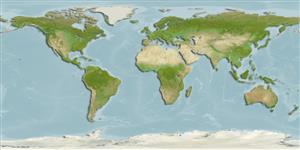Classification / Names
Common names | Synonyms | Catalog of Fishes (gen., sp.) | ITIS | CoL | WoRMS | Cloffa
Actinopterygii (ray-finned fishes) >
Perciformes (Perch-likes) >
Zoarcidae (Eelpouts) > Gymnelinae
Etymology: Opaeophacus: Greek, opaios, -a, -on = with a hole + Greek, phakos = some object of lenticular shape (Ref. 45335). More on author: Stein.
Environment / Climate / Range
Ecology
Marine; bathydemersal; depth range 500 - 800 m (Ref. 11954). Deep-water, preferred ?
North Pacific: Bering Sea.
Size / Weight / Age
Maturity: Lm ? range ? - ? cm
Max length : 15.3 cm SL male/unsexed; (Ref. 11954)
Short description
Morphology | Morphometrics
The captured specimen were associated with an orange coral (Gorgonacea) and a black coral (Antipatharia) (Ref. 11954).
Life cycle and mating behavior
Maturity | Reproduction | Spawning | Eggs | Fecundity | Larvae
Anderson, M.E., 1994. Systematics and osteology of the Zoarcidae (Teleostei: Perciformes). Ichthyol. Bull. J.L.B. Smith Inst. Ichthyol. 60:120 p. (Ref. 11954)
IUCN Red List Status (Ref. 115185)
CITES (Ref. 94142)
Not Evaluated
Threat to humans
Harmless
Human uses
More information
Common namesSynonymsMetabolismPredatorsEcotoxicologyReproductionMaturitySpawningFecundityEggsEgg development
Age/SizeGrowthLength-weightLength-lengthLength-frequenciesMorphometricsMorphologyLarvaeLarval dynamicsRecruitmentAbundance
ReferencesAquacultureAquaculture profileStrainsGeneticsAllele frequenciesHeritabilityDiseasesProcessingMass conversion
Tools
Special reports
Download XML
Internet sources
